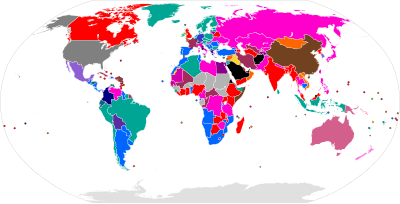
Back نظام انتخابي Arabic Sistema eleutoral AST Seçki sistemi Azerbaijani Избирателна система Bulgarian নির্বাচনী ব্যবস্থা Bengali/Bangla Sistema electoral Catalan Volební systém Czech Valgsystem Danish Wahlsystem German Sistemê weçinıtışi DIQ

Majoritarian system, single-winner districts
Proportional system
Party-list proportional representation
Mixed system
Mixed-member proportional representation
Mixed-member majoritarian representation
Majority bonus/jackpot system
Other
| Part of the Politics series |
| Electoral systems |
|---|
 |
|
|
An electoral system or voting system is a set of rules that determine how elections and referendums are conducted and how their results are determined. Electoral systems are used in politics to elect governments, while non-political elections may take place in business, non-profit organisations and informal organisations. These rules govern all aspects of the voting process: when elections occur, who is allowed to vote, who can stand as a candidate, how ballots are marked and cast, how the ballots are counted, how votes translate into the election outcome, limits on campaign spending, and other factors that can affect the result. Political electoral systems are defined by constitutions and electoral laws, are typically conducted by election commissions, and can use multiple types of elections for different offices.
Some electoral systems elect a single winner to a unique position, such as prime minister, president or governor, while others elect multiple winners, such as members of parliament or boards of directors. When electing a legislature, areas may be divided into constituencies with one or more representatives or the electorate may elect representatives as a single unit. Voters may vote directly for an individual candidate or for a list of candidates put forward by a political party or alliance. There are many variations in electoral systems, the most common being Party-list proportional representation, first-past-the-post voting, plurality block voting, the two-round (runoff) system and ranked voting (STV or Instant-runoff voting). Mixed systems and some other electoral systems attempt to combine the benefits of non-proportional and proportional systems.
The study of formally defined electoral methods is called social choice theory or voting theory, and this study can take place within the field of political science, economics, or mathematics, and specifically within the subfields of game theory and mechanism design. Impossibility proofs such as Arrow's impossibility theorem demonstrate that when voters have three or more alternatives, no preferential voting system can guarantee the race between two candidates remains unaffected when an irrelevant candidate participates or drops out of the election.